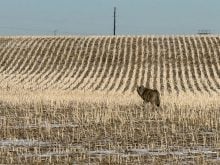Across the west an early seeding season has resulted in near record percentages of seeded land at the end of May’s second week.
Rain fell in many areas across the prairies last week. Token amounts of less than 15 millimetres were reported in most regions with some isolated areas receiving as much as 50 mm.
“Any moisture this year is a welcome sight. It will improve the producers’ outlooks. In reality it will take a lot more than a few showers to get us through this situation, though,” said Wendy Boje of Alberta Agriculture.
Read Also

Agritechnica Day 2: The future of tractor power, building quicker crop apps and large farms and tech
Agritechnica Day 2: The future of tractor power, building quicker crop apps with Syngenta and large farms and tech
There has been little rain where it is needed most, in the western part of the grainbelt. Growers in Manitoba are better off than their western counterparts. Farmers from the Red River Valley west to Virden received several showers over the two-week period beginning May 4.
Between Winnipeg and Portage la Prairie as much as 70 mm of rain fell, delaying some seeding.
Seeding of potatoes and other vegetable crops is nearly complete in the Red River Valley region and 70 percent is finished near Portage la Prairie.
Canola seeding throughout Manitoba is 65 percent complete, well ahead of the five-year average.
Manitoba pastures and forage crops have fared better than most areas on the prairies but dry conditions have still hurt pastures near Virden, Hamiota and Shoal Lake.
“In these areas there is only about 30 percent of the necessary subsoil moisture to produce a forage or hay crop right now. It may be greening up right now but if we don’t get rain soon the pastures will begin to shut down pretty quickly,” said Joanne Buth of Manitoba Agriculture.
Early seeded crops in all regions are emerging.
East of Winnipeg seeding of cereal crops and pulses is 85 percent complete with soil moisture in the good to very good range. Oilseeds are a little behind the grains at 80 percent complete in the eastern region. The Interlake area is latest with 60 to 80 percent of seeding done. Rain held back seeding in this zone but resulted in good to excellent moisture.
Warm temperatures and strong winds characterized much of the weather for producers west of the Manitoba border.
Seeding of cereals and pulse crops is nearly complete in the central and southwest regions of Saskatchewan. Near the Saskatchewan border many producers held back planting until more moisture is available. This is affecting mainly small-seeded crops like canola, mustard, flax and canaryseed.
Soil erosion in western Saskatchewan and eastern Alberta has been reported, along with heat banding on early seeded cereals. The unseasonably warm temperatures and lack of rainfall for most of Alberta and Saskatchewan have allowed producers to seed their earliest crop since 1987.
Minimal rain received
Seeding of cereal and pulse crops in southwestern Saskatchewan is 95 percent complete. Oilseeds are 60 percent complete with many producers opting to hold back in anticipation of rainfall. Subsoil moisture conditions are variable but generally on the low side. Rain, 15 to 30 mm, in the areas around Regina, Weyburn, Swift Current and Moose Jaw will push producers to finish seeding and take advantage of surface moisture.
Terry Karwandy, a Saskatchewan agricultural economist, said 75 percent of the crops in the province are in the ground and that figure will likely jump to nearly 100 percent within the next 10 days.
“The rain we have had this week will get producers out to complete seeding but mostly it will make them feel better about it. The sub-soil moisture levels are so low in many areas that farmers are going to need a lot more rain in order to get an average crop,” said Karwandy.
Compared to the five-year average, seeding in Saskatchewan is more than 45 percent ahead of schedule.
Frost worries
Frost was a concern for several nights for growers in northwestern Saskatchewan and eastern Alberta who were able to establish cereal and canola crops early. Some crops were damaged and producers in the region may reseed. Polish canola and short season peas are the reseeding options being recommended by Saskatchewan Agriculture.
“A lot of producers are waiting things out when it comes to their oilseeds,” said Boje.
Very dry conditions in most of Saskatchewan and Alberta are causing some growers to rethink early seeding plans for mustard, flax and canola.
“They still have a couple of weeks to decide on when and what to plant. If it begins to rain, producers will have easier choices,” she said.
In eastern and southern Alberta seeding of all crops is nearly complete with acceptable to slightly below average subsoil and surface moisture.
After five weeks with little or no rainfall, warm temperatures and high winds have kept moisture levels in all other areas of the province well below average.
Alberta cattle producers are supplementing pastures with feed stocks left from a mild winter and better than average second cut of hay last season.
“For now this will work to keep cattle going but we are hearing from cattlemen that the feed stocks aren’t as good as people might think and this can’t go on forever,” said Boje.
Seeding across the province is 80 percent complete with some growers holding back on their oilseeds until rain is in the forecast.
“In the Peace River region things are better than average moisture wise. And most producers are off to an early start. About 65 percent of the crop is seeded up there.”














